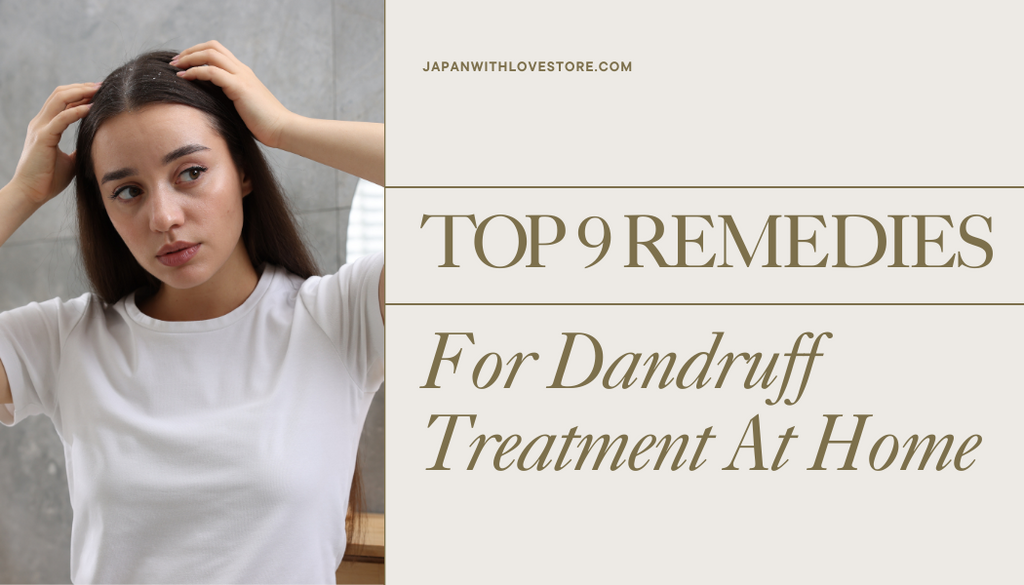
Dandruff, a common scalp condition characterized by flaking of the skin, can be both embarrassing and uncomfortable. While it doesn't typically indicate a serious medical problem, its presence can cause self-consciousness and discomfort.
Fortunately, numerous dandruff treatment at home exist to address dandruff. These remedies encompass a range of natural and easily accessible ingredients, offering individuals effective alternatives to commercial treatments.
In this Japan With Love article, we'll explore the top 9 remedies to treat dandruff at home, providing insight into their effectiveness and application methods to help individuals regain confidence and comfort in their scalp health.
1. Tea Tree Oil
Tea tree oil is an effective way to treat dandruff at home.
Tea tree oil possesses antifungal properties that can help reduce dandruff-causing yeast on the scalp. Tea tree oil is a popular natural remedy for dandruff due to its antifungal, antibacterial, and anti-inflammatory properties. Here's how tea tree oil can be the effective natural dandruff remedies:
-
Antifungal properties: Tea tree oil contains compounds such as terpinen-4-ol that have been shown to exhibit antifungal activity, helping to combat the presence of these fungi on the scalp.
-
Antibacterial properties: By targeting and eliminating bacteria on the scalp, tea tree oil helps to create a healthier environment for the hair follicles and reduces the risk of dandruff formation.
-
Anti-inflammatory properties: Tea tree oil's anti-inflammatory properties can help soothe the scalp, alleviate discomfort, and reduce the urge to scratch, which can exacerbate dandruff symptoms.
To use tea tree oil for dandruff therapy at home, you can follow these steps:
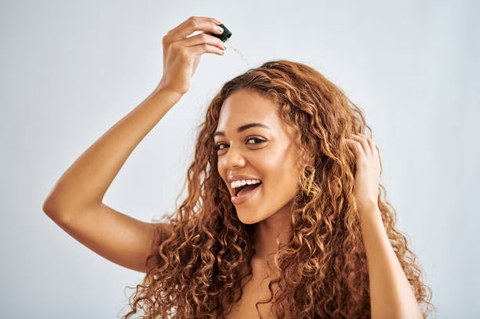
5 easy-to-follow steps that help you get rid of dandruff.
- Dilute a few drops of tea tree oil in a carrier oil such as coconut oil, olive oil, or almond oil.
- Massage the diluted tea tree oil mixture into the scalp, focusing on areas affected by dandruff.
- Leave the oil on for about 30 minutes to an hour to allow it to penetrate the scalp and exert its antifungal and antibacterial effects.
- Rinse out the oil thoroughly with a mild shampoo.
- Repeat this treatment a few times a week until dandruff symptoms improve.
Get this product now P&G H&S Scalp Anti-Dandruff Shampoo Pump For Oily Scalp 350ml - Prevent Dandruff Shampoo.
2. Apple Cider Vinegar
You can use apple cider vinegar to eliminate dandruff.
Apple cider vinegar (ACV) is a popular dandruff treatment at home due to its acidic nature and potential antifungal properties. Here's how this natural dandruff cure can be done:
- Balancing Scalp pH: By restoring the scalp's natural acidity, apple cider vinegar helps to discourage the proliferation of these fungi and reduce dandruff.
- Antifungal Properties: By reducing the population of these fungi, apple cider vinegar effectively treats dandruff and prevents its recurrence.
- Exfoliating Effect: Apple cider vinegar can act as a natural exfoliant for the scalp. Its acidic properties help to loosen and remove dead skin cells, excess oil, and buildup from the scalp's surface.
Here are simple steps to use apple cider vinegar for dandruff treatment home remedies:
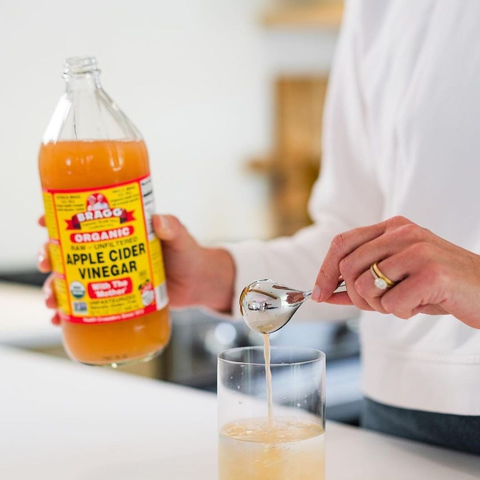
Apple cider vinegar is not just used for cooking; it's also a saver for your scalp.
- Dilute apple cider vinegar with an equal amount of water to reduce its acidity and prevent potential irritation to the scalp.
- After shampooing, apply the diluted apple cider vinegar solution to your scalp.
- Massage it gently into the scalp and leave it on for about 5 to 15 minutes to allow it to penetrate and exert its effects.
- Rinse your hair thoroughly with water to remove the vinegar solution.
- You can follow up with a conditioner if desired to help soften and detangle your hair.
- Repeat this treatment once or twice a week until dandruff symptoms improve.
Get this now Maro Deo Scalp Treatment Men'S Medicated Dandruff Itch Odor Prevention Japan 480Ml
3. Coconut Oil
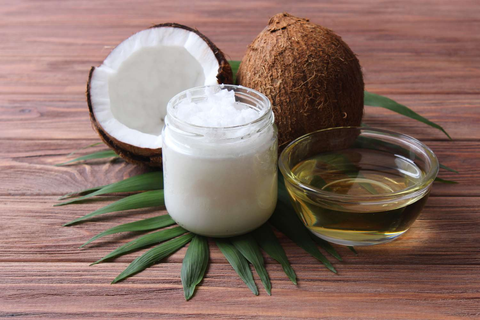
Coconut oil is very famous for its great uses in different fields.
Coconut oil is a versatile natural remedy that can be such a highly-recommended dandruff therapy at home through various mechanisms:
- Moisturizing Properties: Applying coconut oil to the scalp helps to hydrate the skin, reducing dryness and flakiness associated with dandruff.
- Antifungal Activity: Coconut oil contains compounds such as caprylic acid and lauric acid, which have been found to possess antifungal properties. These compounds can help combat the overgrowth of Malassezia, a type of yeast-like fungus that contributes to dandruff.
- Anti-inflammatory Effects: By calming inflammation, coconut oil provides relief from the discomfort caused by dandruff, promoting a healthier scalp environment.
To use coconut oil for dandruff treatment at home, follow these steps:
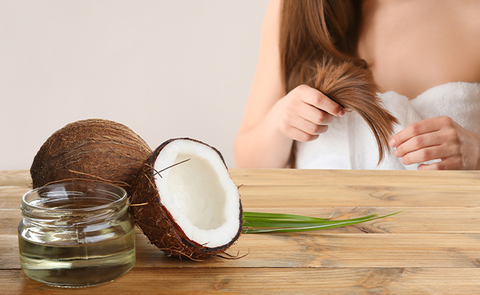
Using coconut oil every day is really good for your hair.
-
Warm the coconut oil: Place a small amount of coconut oil in a bowl and warm it slightly until it becomes liquid. You can do this by placing the bowl in warm water or microwaving it for a few seconds.
-
Apply to the scalp: Part your hair into sections and apply the warm coconut oil directly to your scalp. Use your fingertips to massage the oil gently into the scalp, ensuring even distribution.
-
Leave it on: Leave the coconut oil on your scalp for at least 30 minutes to allow it to penetrate the skin and hair follicles. For best results, you can leave it on overnight by covering your head with a shower cap or towel.
-
Wash out: After the desired time, wash your hair thoroughly with a mild shampoo to remove the coconut oil. You may need to shampoo twice to ensure all the oil is removed.
-
Repeat: Repeat this treatment 2-3 times per week until you notice an improvement in your dandruff symptoms.
4. Aloe Vera
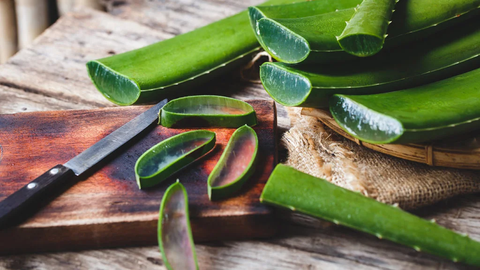
Aloe vera is also a home remedy for dandruff that you should not ignore.
Aloe vera is a natural plant with a myriad of health benefits, including its ability as a dandruff treatment at home. Here's how aloe vera can effectively address dandruff:
- Soothing and Moisturizing: Aloe vera contains enzymes, vitamins, and minerals that nourish and moisturize the scalp. By moisturizing the scalp, aloe vera promotes a healthier environment for the hair follicles and reduces the risk of dandruff formation.
- Antifungal and Antibacterial: Aloe vera possesses antifungal and antibacterial properties, which can help combat the underlying causes of dandruff. By addressing these microbial factors, aloe vera helps to control dandruff and prevent its recurrence.
- Anti-inflammatory: Dandruff often leads to scalp inflammation, resulting in redness, irritation, and discomfort. By calming the scalp, aloe vera provides relief from dandruff symptoms and promotes overall scalp health.
To use aloe vera for dandruff therapy at home, follow these steps:
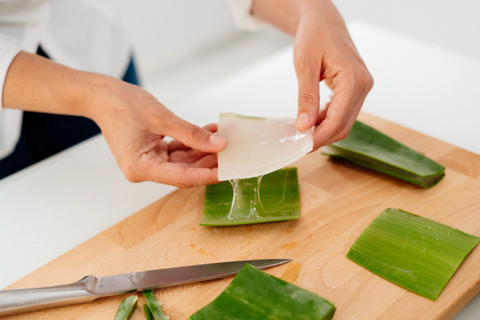
This dandruff treatment method is both cost-saving and highly effective.
-
Extract Aloe Vera Gel: Cut a fresh aloe vera leaf and scoop out the gel using a spoon. You can also use commercially available pure aloe vera gel if fresh aloe vera is not available.
-
Massage the aloe vera gel straight onto your scalp, focusing on dandruff-prone regions. Make sure the gel covers the entire scalp and is evenly spread.
-
Keep it on: Apply the aloe vera gel to your scalp for 30 minutes to an hour to allow it to infiltrate the skin and provide hydrating and healing benefits.
-
Wash Out: After the recommended time, thoroughly rinse your hair and scalp with lukewarm water. If necessary, use gentle shampoo afterwards.
-
Repeat: Continue this treatment 2-3 times per week until you see an improvement in your dandruff symptoms.
May be you wonder Why should we use japanese shampoo? Find the answer with us now!
5. Baking Soda
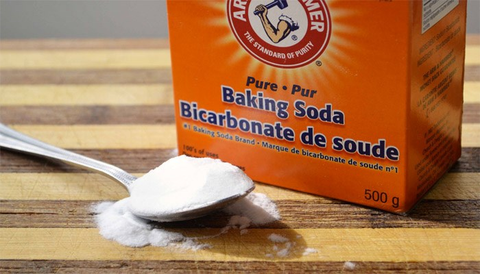
Baking soda is also a perfect choice for your dandruff-prone scalp.
Baking soda, also known as sodium bicarbonate, can be an effective natural dandruff treatment due to its exfoliating and antifungal properties. Here's how baking soda can help treat dandruff at home:
- Exfoliation: Baking soda can gently exfoliate to reduce the buildup of flakes and unclog hair follicles, which can contribute to dandruff.
- pH Balancing: By restoring the pH balance of the scalp, baking soda creates a less hospitable environment for these microorganisms, helping to alleviate dandruff.
- Antifungal Properties: By reducing the population of Malassezia on the scalp, baking soda helps to control dandruff and prevent its recurrence.
To use baking soda for dandruff treatment at home, follow these steps:
Baking soda is not only used for cooking but also helps in hair care.
-
Make a Baking Soda Paste: Combine 1-2 tablespoons of baking soda with enough water to produce a smooth paste. You can vary the amount of water to obtain the desired texture.
-
Apply to the Scalp: Divide your hair into parts and rub the baking soda paste straight onto your scalp. Massage the paste gently into the scalp with your fingertips, paying special attention to dandruff-prone regions. Make sure the paste covers the entire scalp.
-
Leave it On: For 5-10 minutes, apply the baking soda paste on your scalp to exfoliate and absorb excess oil. Avoid leaving it on for too long, as baking soda will dry out the scalp.
-
Cleanse Out: After the recommended time, thoroughly rinse your hair and scalp with lukewarm water. If any residue remains, use a gentle shampoo to remove it.
-
Repeat: Apply this treatment 1-2 times each week till your dandruff problems improve.
6. Neem (Indian Lilac)
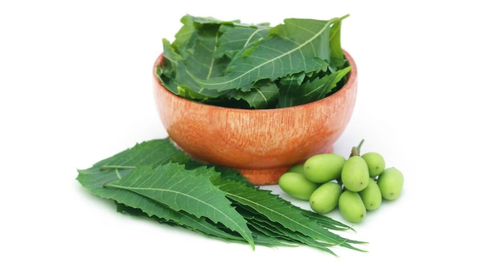 Neem (Indian Lilac) is a very popular natural remedy to treat dandruff at home.
Neem (Indian Lilac) is a very popular natural remedy to treat dandruff at home.Neem, also known as Indian Lilac, is a powerful natural dandruff cure at home due to its antifungal, antibacterial, and anti-inflammatory properties. Here's how neem can effectively address dandruff:
- Antifungal Properties: Neem contains compounds such as nimbidin and nimbin that exhibit potent antifungal activity. By reducing the population of Malassezia on the scalp, neem helps to control dandruff and prevent its recurrence.
- Antibacterial Properties: By targeting and neutralizing these harmful bacteria, neem promotes a healthier scalp environment and reduces the risk of dandruff formation.
- Anti-inflammatory Effects: By calming the scalp, neem provides relief from dandruff symptoms and promotes overall scalp health.
To use neem for dandruff treatment at home, follow these steps:
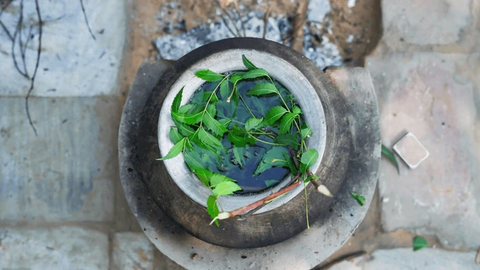
This treatment is both safe, effective and cost-effective.
-
Prepare Neem Solution: Boil neem leaves in water until the water changes color and the leaves become soft. Alternatively, you can use neem oil, which is readily available in stores and online.
-
Strain the Solution: Once the neem leaves have boiled, strain the liquid to remove any solid particles. Allow the neem solution to cool down to a comfortable temperature before use.
-
Apply to the Scalp: Pour the neem solution over your scalp, ensuring that it covers the entire scalp area. Use your fingertips to massage the solution gently into the scalp, focusing on areas affected by dandruff.
-
Leave it On: Leave the neem solution on your scalp for about 20-30 minutes to allow it to penetrate the skin and exert its antifungal and antibacterial effects.
-
Clean Out: After the recommended time, properly rinse your hair and scalp with lukewarm water. If any residue remains, use a gentle shampoo to remove it.
- Keep doing this treatment 2-3 times each week till you see an improvement in your dandruff problems.
Find out which Japanese shampoo is suitable for your Japanese haircare routine now!
7. Lemon Juice
Although lemon juice is familiar, not everyone knows its magical uses.
Lemon juice can be an effective natural dandruff treatment due to its acidic nature and natural antifungal properties. Here's how lemon juice can effectively address dandruff:
- pH Balancing: By restoring the pH balance of the scalp, lemon juice creates a less favorable environment for these microorganisms, helping to alleviate dandruff.
- Antifungal Properties: By reducing the population of Malassezia on the scalp, lemon juice helps control dandruff and prevent its recurrence.
- Exfoliation: The acidic nature of lemon juice also acts as a gentle exfoliant, helping to remove dead skin cells and excess oil from the scalp.
To use lemon juice for dandruff treatment at home, follow these steps:

Treating dandruff at home with lemon juice is both easy and safe.
-
Prepare Lemon Juice Solution: Squeeze fresh lemon juice from a lemon into a bowl. You can dilute the lemon juice with equal parts of water to reduce its acidity, especially if you have sensitive skin.
-
Apply to the Scalp: Using a cotton ball or your fingertips, apply the lemon juice solution directly to your scalp. Massage it gently into the scalp, focusing on areas affected by dandruff. Ensure that the entire scalp is covered with the lemon juice solution.
-
Let it On: Apply the lemon juice solution to your scalp for 5-10 minutes to let it work its magic. Avoid leaving it on for too long, since the acidity of lemon juice might irritate the scalp over time.
-
Rinse Out: After the recommended time, thoroughly rinse your hair and scalp with lukewarm water. If any residue remains, use a gentle shampoo to remove it.
-
Again: Apply this treatment 1-2 times each week till your dandruff problems improve.
Here are the Best Japanese Shampoo For Your Hair Type - Have you heard of it?
8. Yogurt

Now you know, yogurt is not only good for digestion but also good for hair.
Yogurt can be a friendly dandruff treatment at home due to its probiotic properties and its ability to restore the natural balance of scalp flora. Here's how yogurt can effectively address dandruff:
- Probiotic Properties: By introducing probiotics to the scalp, yogurt helps to inhibit the growth of these harmful microorganisms and promote a healthier scalp environment.
- Moisturizing and Nourishing: By moisturizing the scalp, yogurt promotes a healthier environment for the hair follicles and reduces the risk of dandruff formation.
- Exfoliation: The lactic acid present in yogurt acts as a gentle exfoliant, helping to remove dead skin cells and excess oil from the scalp. This exfoliating action helps reduce the buildup of flakes and unclog hair follicles, which can contribute to dandruff.
To use yogurt for dandruff treatment at home, follow these steps:
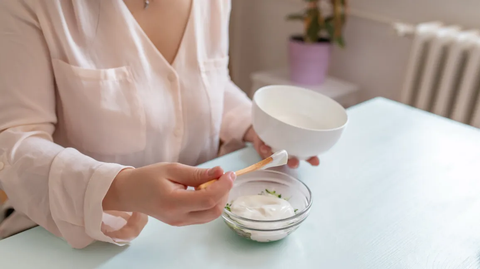
Using yogurt to remove dandruff is a safe and easy method to do at home.
-
Choose Plain Yogurt: Opt for plain, unsweetened yogurt without any added flavors or sweeteners. Greek yogurt is a good choice as it tends to be thicker and richer in nutrients.
-
Apply to the Scalp: Massage the plain yogurt directly onto your scalp, ensuring that it covers the entire scalp area. Use your fingertips to massage the yogurt gently into the scalp, focusing on areas affected by dandruff.
-
Leave it On: Leave the yogurt on your scalp for about 15-20 minutes to allow it to penetrate the skin and exert its moisturizing and nourishing effects.
-
Rinse Out: After the desired time, rinse your hair and scalp thoroughly with lukewarm water. You can follow up with mild shampoo if necessary to remove any residue.
-
Repeat: Repeat this treatment 2-3 times per week until you notice an improvement in your dandruff symptoms.
9. Olive Oil
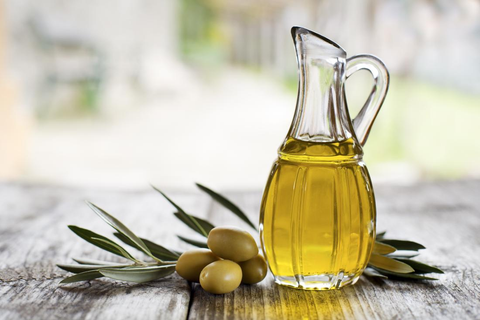
There is no debate that olive oil is the most favorite factor in skin and hair care.
Olive oil can be one of the beneficial natural dandruff remedies due to its moisturizing and nourishing properties. Here's how olive oil can effectively address dandruff:
- Moisturizing: Dry scalp is a common cause of dandruff, and by moisturizing the scalp, olive oil helps alleviate dryness, flakiness, and itching associated with dandruff.
- Antifungal Properties: By reducing the population of Malassezia on the scalp, olive oil helps to control dandruff and prevent its recurrence.
- Anti-inflammatory Effects: By calming the scalp, olive oil provides relief from dandruff symptoms and promotes overall scalp health.
To use olive oil for dandruff treatment at home, follow these steps:
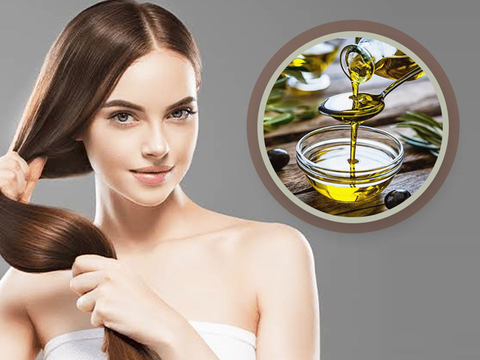
You will be surprised to use olive oil to treat dandruff.
-
Choose extra virgin olive oil: Opt for extra virgin olive oil, as it is the least processed and retains the highest levels of nutrients and antioxidants.
-
Warm the olive oil: Place a small amount of olive oil in a bowl and warm it slightly until it becomes lukewarm. You can do this by placing the bowl in warm water or microwaving it for a few seconds.
-
Apply to the scalp: Part your hair into sections and apply the warm olive oil directly to your scalp. Use your fingertips to massage the oil gently into the scalp, ensuring even distribution.
-
Leave it on: Leave the olive oil on your scalp for about 30 minutes to an hour to allow it to penetrate the skin and hair follicles. For deeper conditioning, you can leave it on overnight by covering your head with a shower cap or towel.
-
Rinse out: After the desired time, wash your hair thoroughly with a mild shampoo to remove the olive oil. You may need to shampoo twice to ensure all the oil is removed.
-
Repeat: Repeat this treatment 2-3 times per week until you notice an improvement in your dandruff symptoms.
Find out the best Japanese hair care routine for your hair type today!
Conclusion
Using natural dandruff treatment can be both effective and convenient. The top nine remedies discussed—tea tree oil, apple cider vinegar, coconut oil, aloe vera, baking soda, neem (Indian lilac), lemon juice, yogurt, and olive oil—offer a variety of approaches to address the underlying causes of dandruff and alleviate its symptoms.
These remedies offer natural and affordable options for dandruff treatment at home, providing relief from itching and flaking while promoting overall scalp health. However, if dandruff persists or worsens despite home treatment, it's advisable to consult a dermatologist for further evaluation and treatment.
For a daily dose of beauty inspiration and the latest trends, join Japan With Love's journey today!
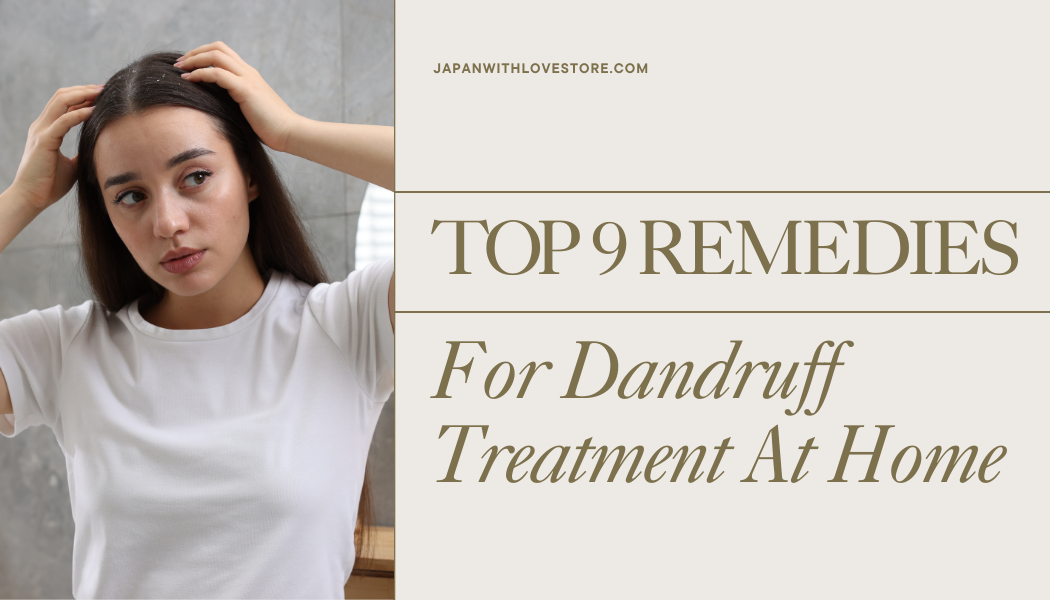

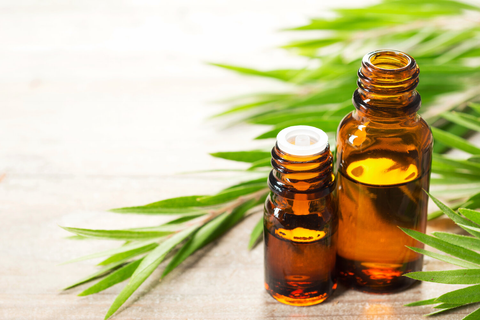

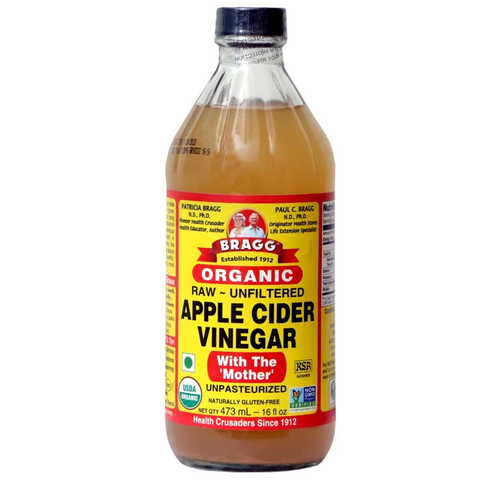






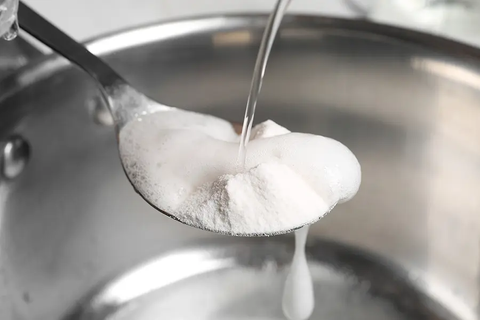
 Neem (Indian Lilac) is a very popular natural remedy to treat dandruff at home.
Neem (Indian Lilac) is a very popular natural remedy to treat dandruff at home.
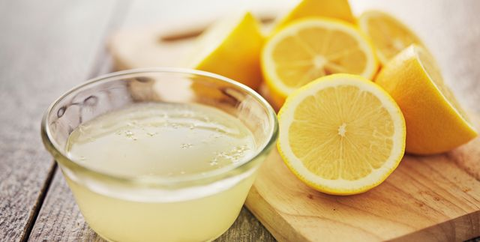





Compartir:
Beneficios del champú sin sulfato: ¿por qué es bueno para tu cabello?
Lavado facial vs. Limpiador: las diferencias que debe conocer